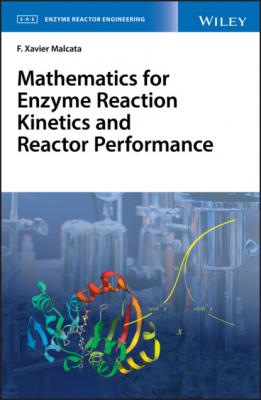Mathematics for Enzyme Reaction Kinetics and Reactor Performance. F. Xavier Malcata
Читать онлайн.| Название | Mathematics for Enzyme Reaction Kinetics and Reactor Performance |
|---|---|
| Автор произведения | F. Xavier Malcata |
| Жанр | Химия |
| Серия | |
| Издательство | Химия |
| Год выпуска | 0 |
| isbn | 9781119490333 |
for a ≡ 10 and b ≡ e – thus making a tool available to convert a natural exponential to a decimal exponential; note ln 10 appearing again as conversion factor, in parallel to Eq. (2.32).
Complex functions do often exhibit simple linear behaviors near specific finite value(s), or when their independent variable grows unbounded toward either −∞ or ∞; such a driving line – originally described by Apollonius of Perga in the Greek Antiquity, is termed asymptote, and represents a straight line tangent to the germane curve at infinity. A vertical asymptote is accordingly defined by
(2.36)
or
(2.37)
typical examples of a are the zeros of the denominator (or poles) of rational functions, or the value(s) that turn nil the argument of a logarithmic function. Oblique asymptotes abide, in turn, to
– which will, in particular, be horizontal if b = 0; division of both sides by x transforms Eq. (2.38) to
(2.39)
because 0/x = 0 for x ≠ 0 (as is the case) – where a/x becoming, in turn, negligible when x → 0 permits simplification to
If the limit described by Eq. (2.40) does not exist, then there is no oblique asymptote in that direction; otherwise, one may proceed and compute a from Eq. (2.38) via
(2.41)
where b obviously abides to Eq. (2.40). Although the concept of asymptote may be extended to other polynomial forms (e.g. quadratic) using essentially the same rationale, their determination (and usefulness) is far less common and rather limited.
When in the presence of two (or more, say, n) real values, one may define the most likely value, or arithmetic mean (referred to via subscriptarm, with
by the same token, one can define a geometric mean (referred to via subscriptgem) as
The harmonic mean (referred to via subscriptham) satisfies
or, after taking reciprocals of both sides,
the aforementioned three means are useful in a great many problems – depending on the underlying mathematical nature of the data, so their relative location deserves further exploitation (as done below).
Consider, for simplicity, only two values x1 and x2; after realizing that
(2.46)
for being a square – with validity assured irrespective of the relative magnitude of x1 and x2, one may apply Newton’s binomial (to be considered shortly) to write
Upon addition of 4x1 x2 to both sides, Eq. (2.47) becomes
(2.48)
– where Newton’s binomial may again be invoked to support condensation to
If square roots are taken of both sides, then Eq. (2.49) transforms to
(2.50)
on the common assumption that both x1 and x2 are positive – whereas division of both sides by 2 unfolds
(2.51)
based on Eqs. (2.42) and (2.43), one concludes that
– i.e. the arithmetic mean of two numbers never lies below their geometric mean (being equal only when x1 = x2).
On the other hand, inspection of Eq. (2.44) vis‐à‐vis with Eq. (2.42) indicates that
